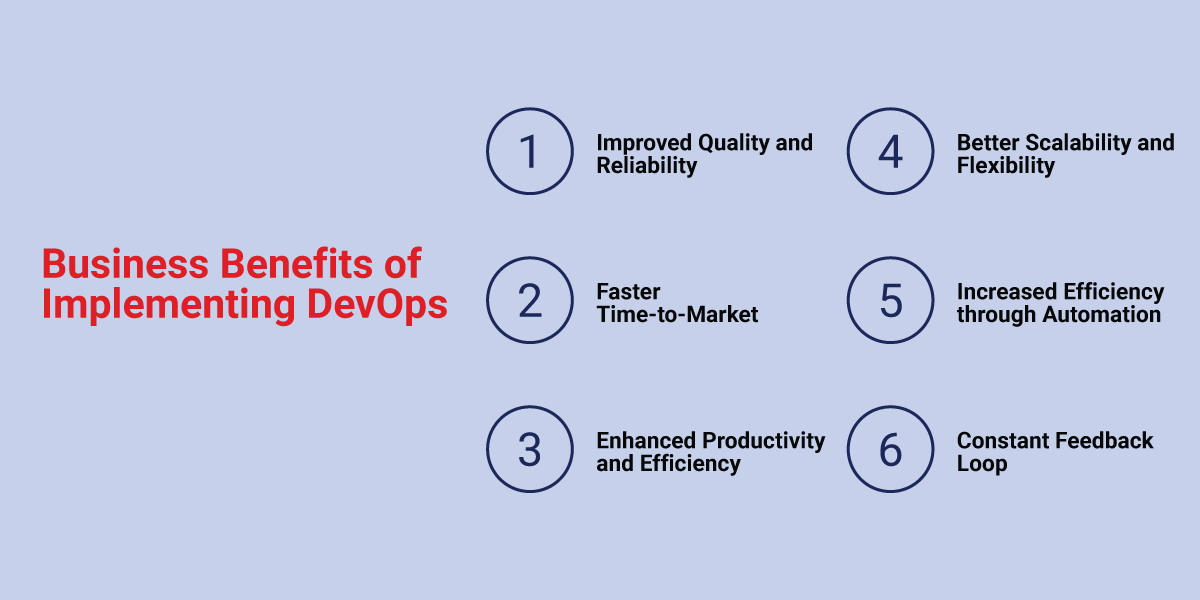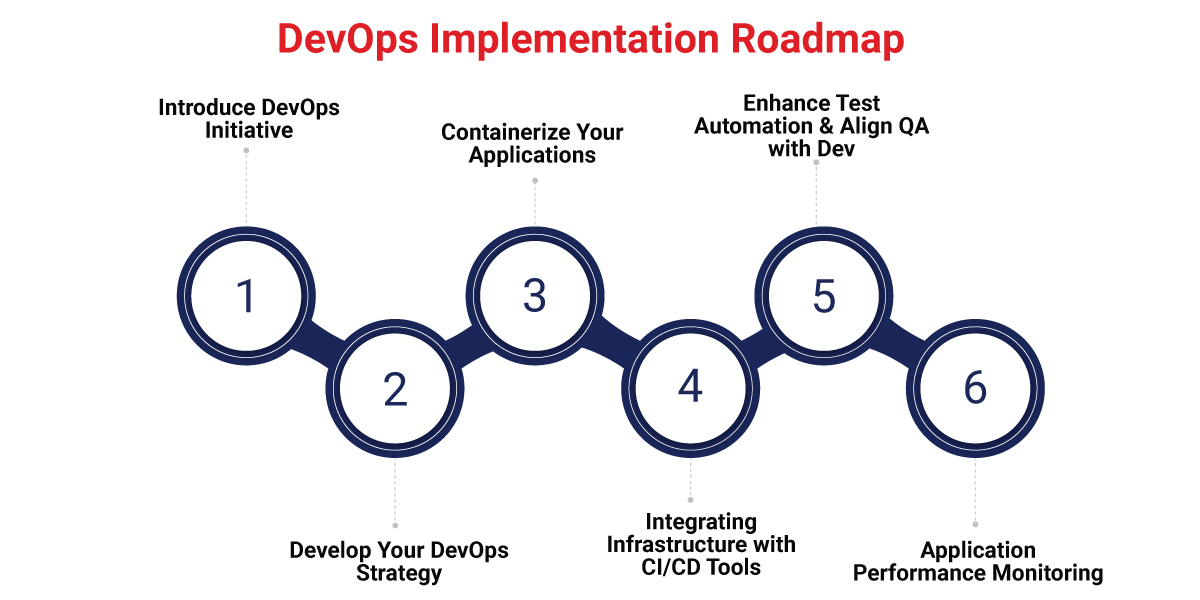Organizations across various domains strive to achieve greater efficiency in software development and operations for faster release of new products to respond to changes in the market. But multiple pitfalls come in between achieving this goal, such as:
- A disorganized clutter of tools and workflows in your software development lifecycle
- Silos between Dev and Ops
- Struggling to deploy software faster without bugs
- Optimizing resources for hassle-free software development
The above concerns have probably been on your mind, too, at one point or another. To overcome this, implementing DevOps is the ideal solution you have. This powerful approach will overcome all the SDLC barriers and give you smooth development outcomes. It simplifies development and deployment procedures, resulting in more effective team collaboration and communication among the members. However, despite these advantages, it is important to create a proper DevOps implementation plan for an organization to be able to use its full potential.
To give you a detailed overview, let’s explore how to implement DevOps from scratch, the benefits of DevOps, and what should be included in the implementation roadmap, along with key metrics to measure DevOps success.
What is DevOps?
DevOps is a combination of tools, practices, and a cultural philosophy that helps organizations deliver new software and services faster. DevOps implementation improves collaboration between traditionally siloed software development and IT operations to foster a culture of shared responsibility. It is aimed at assisting businesses in releasing their products at faster rates than the traditional procedures followed in software development. This agility can help organizations fulfill customer expectations more efficiently and compete on a better footing in the market.
Business Benefits of DevOps Implementation
Implementing DevOps brings numerous benefits to your software development lifecycle. Let’s dive deep into some of the main advantages of DevOps and how it is transforming the way software development works.

Improved Quality and Reliability
A DevOps-based organization focuses on collaboration throughout the development lifecycle by introducing robust sync between the development and operations teams. This helps identify and address issues earlier in development, leading to higher-quality software and more reliable deployments.
Faster Time-to-Market
One prominent practice of DevOps is continuous integration and deployment (CI/CD), which helps organizations quickly release high-quality software. This allows organizations to respond to market demands quickly, launch new products and solutions, deploy software, and stay ahead of the competition.
Enhanced Productivity and Efficiency
By automating repetitive tasks and eliminating manual handoffs between teams, DevOps implementation can significantly improve the overall efficiency and productivity of the software development and delivery process. Through this, both the teams, development and operations, can work closely to enhance workflows and fix all issues faster. This will also help teams to focus on more crucial and value-adding activities.
Better Scalability and Flexibility
This approach promotes a culture of continuous improvement and automation, allowing organizations to scale infrastructure and applications to meet changing business needs. Using popular DevOps practices like Infrastructure as Code (IaC), Microservices architecture, automated provisioning and deployment, organizations can scale their resources as required to support faster growth and quickly adapt to changing market demands.
Increased Efficiency through Automation
This process focuses more on automation throughout the software development pipeline to reduce bottlenecks and enable a more robust SDLC. Implementing automation helps reduce manual errors, increase efficiency, and accelerate the delivery of software updates.
Constant Feedback Loop
It is one of the core principles of DevOps. Teams regularly gather data and insights about the software’s performance in the real-world production environment and thrive on constant feedback.
DevOps Implementation Roadmap
DevOps implementation plan is a step-by-step process for implementing this transformational approach in an organization. It helps overcome DevOps adoption challenges while also improving delivery velocity. The roadmap traces the critical cultural and technical changes needed for a more efficient and collaborative software development process.

Step #1 Initiating a DevOps Journey
The DevOps initiative is the first crucial step in achieving excellent outcomes from this methodology. Usually, the CIO is a strategic driver for the DevOps initiative, integrating it with the broader IT strategy.
- Assessing the Current Situation of the Project: The initial stage in the roadmap is to get a clear picture of your organization’s existing software development and IT operations processes. You need to identify,
- Bottlenecks
- Set DevOps vision & goals,
- Define DevOps tasks and
- Create a shared understanding of practices within the project.
- Build a Cross-Functional Team: Organizations must assemble a diverse team of stakeholders with unique skills and expertise to get the most out of this implementation plan.
- Develop a Roadmap Strategy: The program manager will next create a comprehensive roadmap/strategy aligned with the organization’s objectives and be responsible for its efficient implementation.
#Step 2 Develop Your DevOps Strategy
Now based on the assessment and understanding of the initial stage, the next step is to develop a robust DevOps strategy. This involves:
- Assess the Current Tools and Processes: Identify the existing tools, technologies, and processes used for software development, testing, and deployment.
- Identify Areas for Improvement: Based on the above assessment, you should pinpoint the areas that require the most attention, such as collaboration, automation, or monitoring.
- Prioritize Initiatives: Prioritize the DevOps initiatives based on their potential impact, complexity, and alignment with the organization’s goals.
- Communicate the Strategy: Convey clear and precise DevOps strategy to all stakeholders, ensuring alignment and buy-in across the organization.
Step# 3 Containerize Your Applications
It helps the team to deploy and run the applications more efficiently and consistently across any environment, from development to production. It is one of the most crucial components of the DevOps implementation roadmap. Select a container platform like Docker or Kubernetes that enhances software reliability and offers consistent deployment across different environments without dependency. It also helps streamline operations management to make any changes needed for a particular microservice.
Step#4 Integrating Infrastructure with CI/CD Tools
When working with containers, it’s essential to have a smooth process for setting up and managing the infrastructure that runs your applications. Containerized applications require proper management, which could be achieved by merging infrastructure-automating tools (Kubernetes, Ansible, or Chef) with CI/CD tools (such as Jenkins, Bamboo, or GoCD). This integration will resolve effective configuration management and deployment concerns.
Step#5 Enhance Test Automation & Align QA with Dev
Next, the software team conducts test automation to identify bugs, ensuring code quality and expediting delivery cycles. Simultaneously, aligning QA practices with development is critical to address post-release issues. Although automation helps achieve an efficient software delivery cycle, not every test needs to be automated. You must evaluate the number of iterations each test needs and ask yourself: Is it worth the effort to automate a test? This evaluation will help you understand which tests need to be automated. It is a good practice at this stage to ensure close collaboration between the QA and the development team to get early feedback and faster issue resolution.
Step#6 Measure and Optimize
Application Performance Monitoring (APM) helps the DevOps teams with better transparency about the overall performance issues in the software lifecycle. It also helps to detect application defects, prioritize them, and isolate them before they affect users, like slow loading times or crashes. APM also helps pinpoint the exact cause of these issues quickly so you can fix them faster.
Key Metrics That Determine DevOps Success
DevOps success goes beyond just implementing the practices. It’s about measuring the impact those practices have on your development process. Here are some key metrics that can help you decide how well your DevOps initiatives are working:
Delivery Performance
- Deployment Frequency: How often are you deploying new features and updates? Frequent deployments indicate faster time to market and a more responsive development process.
- Lead Time for Changes: This measures the time it takes for a change to go from idea to deployment. Shorter lead times suggest a more efficient development lifecycle.
Quality and Reliability
- Change Failure Rate: How often do deployments fail or introduce new bugs? A lower failure rate signifies a more stable and reliable development process.
- Mean Time to Recover (MTTR): This measures how long it takes to fix an issue after it’s detected. A faster MTTR minimizes downtime and keeps your systems running smoothly.
Collaboration and Efficiency
- Deployment Time: How long does it take to deploy a new update or feature? Faster deployment times mean less disruption and quicker value delivery.
- Cycle Time: This measures the overall time it takes to complete a development task, from start to finish. Shorter cycle times indicate a more efficient workflow.
Why Choose Rishabh Software for DevOps Implementation?
Rishabh Software’s DevOps implementation services are deeply rooted in a mindset prioritizing delivery excellence, agile culture, and process orientation. Our commitment to industry-standard practices and principles such as BDD, TDD, and CI/CD ensures easily maintainable code and low technical debt with each project.
With years of experience supporting organizations of all sizes in implementing DevOps processes and practices, our highly experienced DevOps consultant can help you implement a robust approach that speeds up your software delivery cycle and improves quality and reliability.
Frequently Asked Questions
Q: What are the key principles of a successful DevOps culture?
A: Here are the fundamental principles of DevOps that help in efficient implementation.
- Collaboration: The key reason behind DevOps implementation is collaboration between Development and operations teams. This will lead the overall software development process towards better collusion, responsibility, and enhanced knowledge sharing.
- Automation: By eliminating human intervention and substituting all manual procedures with automated applications, these tools assist in simplifying processes, eliminating errors, and improving effectiveness across the lifecycle of software development.
- Continuous Monitoring: This principle allows the organization to have immediate visibility into system behavior, facilitating faster resolution of issues. It contributes to steady growth towards development as a whole.
- Continuous Improvement: It encourages development and operations teams to review their processes and identify areas for advancement.
- Culture of Learning and Improvement: DevOps encourages continuous learning, experimentation, and iterative refinement, where teams are empowered to take risks and learn from failures.
Q: What are the 5 pillars of DevOps?
A: The five pillars of DevOps are called CALMS (Culture, Automation, Lean, Measurement, Sharing). Below is a brief overview of each aspect.
- Culture: It is a fundamental pillar of DevOps that includes principles and practices for guiding teams to witness a collaborative, flexible, and learning-oriented environment.
- Automation: The second pillar discusses implementing/using tools and procedures to automate various software development, testing, and deployment processes.
- Measurement: It means continuously measuring and monitoring data and statistics to monitor and improve the performance of applications. Teams should keep an eye on KPIs and find areas for improvement.
- Sharing: This is all about sharing knowledge, resources, and insights with teams to maintain transparency and clear communication across teams for the success of DevOps.
- Learning: The continuous learning and development process is the motto under this final pillar. Teams must try new things, take risks, and learn from their mistakes in a DevOps culture.
Q: What not to expect from DevOps implementation?
A: Below are the things that you should not expect from DevOps implementation
- Overnight transformation: DevOps is a cultural and organizational shift, not a quick fix. Expect a gradual process of change rather than immediate, dramatic results.
- Elimination of all issues: This approach aims to improve processes and workflows but cannot solve all problems or eliminate errors. Continuous improvement is the goal.
- Reduced costs: While this methodology can increase efficiency, the initial investment in tools, training, and process changes may increase costs before long-term savings are realized.
- Elimination of the operations team: It focuses more on collaboration between dev and ops, but the operations function remains essential and is not made obsolete.
- One-size-fits-all approach: It should be tailored to the specific needs and context of the organization, not a generic, universal solution.
Q: Can DevOps be applied to all types of projects and industries?
A: DevOps principles and practices apply not only to software development but also to a wide variety of projects and industries in which they can be applied.
Basic concepts of collaboration, automation, monitoring, and continuous improvement can be customized for different fields, including infrastructure management, data engineering, and even some non-technical business activities. The DevOps techniques one can adopt are relevant within a particular situation and encompass pain points, bottlenecks, and possibilities for enhancement.











 30 Min
30 Min


